


|
|
|
TAKE 3,600 palms sprawled over 65 acres with an average annual yield of over 100 coconuts per tree. That�s a lot of coconuts. Ratnagiri�s palm fringed coastline is suitably enough the location of the Konkan Krishi Vidyapeeth�s Regional Coconut Research Station. Most homes have at least one in their backyard, local farmers grow them in abundance, the fruit graces many auspicious occasions and Ratnagiri�s tiny airstrip is lined with a neat row of a dozen odd coconut trees. This is a tree to be reckoned with in the region. The research station located on the mouth of the river Kajali and across the road from the Bhatye
The centre is one of 16 located across the country, the Ratnagiri branch having been established in July 1955. Their main objectives are the collection, conservation, cataloguing and evaluation of new hybrids and high yielding varieties of coconut. They also develop improved propagation techniques for a variety of elite spices as well as effective and efficient pest control measures. Their know-how is more importantly put to good use and the centre actively guides farmers or even those of us who fancy ourselves as having a bit of a green finger and a little land to experiment on with advice.
As a quick drive around villages in Ratnagiri shows not all farmers have the luxury of acre plots. A farm could also be the one mango tree, patch of tomato and lemon bush in the garden. Aware of this they have smaller models based on acre plots, replete with a cleverly constructed bamboo gate and farmer�s hut. The centre, Nagwekar explained, also tried intercropping several vegetables between coconut trees. Planting chillies increased the scope for better employment opportunities and income to the coconut grower. On a monetary basis, planting tomato underneath your coconuts is best, followed by capsicum and a strange vegetable called knoll kohl (turnips). The excellent growth and good bearing capacity of cinnamon, nutmeg, black pepper, and cloves, planted among the coconuts as intercrops has also proved that the spices can be cultivated on a commercial scale inthe Konkan region.
Nutmeg, which is the most profitable of the spices, is harvested from April to June. The red waxy mace used in biryani wraps the fruit and is sold for Rs. 500-600 per kg. The rind is used to make pickle and jam. Black pepper is also grown in abundance. The spice initially looks green until it is dipped in boiling water and then left to dry. It�s the sturdy coconut harvested all year round though that remains the focus of things at the research centre. Unlike the more delicate spices that grow below, this is one tough nut. There are 27 varieties growing here but to us one coconut looked like any other!
Regional Coconut Research Station,
|

Home Page
About the mag
Subscribe
Advertise
Contact Us
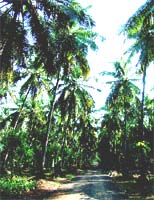 Coconuts & Spice & Everything Nice!
Coconuts & Spice & Everything Nice!
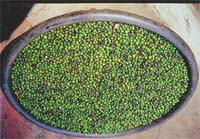 Beach, does just that. We were shown around the tranquil and lush plantation by Dilip Nagwekar, the affable and informative head of the centre, who pointed out that it was not just coconuts but also an assortment of spices that grew in abundance. What followed was a quick and insightful glimpse into all things coconut and spice laden.
Beach, does just that. We were shown around the tranquil and lush plantation by Dilip Nagwekar, the affable and informative head of the centre, who pointed out that it was not just coconuts but also an assortment of spices that grew in abundance. What followed was a quick and insightful glimpse into all things coconut and spice laden.
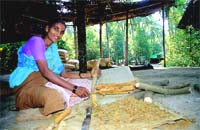 This advice can go a long way if things go as planned � Rs. 1 lakh of long way to be exact. The university established the Lakhi Baug� concept on the basis of a mixed cropping experiment on spices and coconut. For example, if spices like cinnamon, nutmeg and black pepper are intercropped, say 123 cinnamon, 54 nutmeg and 140 black pepper trees in a one-acre plot with approximately 70 coconut trees, the land would eventually give the farmer a return of a lakh.
This advice can go a long way if things go as planned � Rs. 1 lakh of long way to be exact. The university established the Lakhi Baug� concept on the basis of a mixed cropping experiment on spices and coconut. For example, if spices like cinnamon, nutmeg and black pepper are intercropped, say 123 cinnamon, 54 nutmeg and 140 black pepper trees in a one-acre plot with approximately 70 coconut trees, the land would eventually give the farmer a return of a lakh.
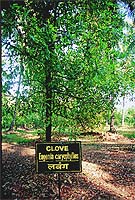 Aside from growing these spices by the basketful, the centre also sells them seasonally on site. The day we visited, it was cinnamon that was being tended to. The process is a labour intensive one and women are hired on a daily basis to painstakingly remove peels of cinnamon from the bark. This is then wound round a tall piece of wood to prevent the cinnamon from curling up and to allow the insides to dry completely. The strips of cinnamon were surprisingly sweet and rather delicious. Products of Tree No. 4, �Konkan Tej� variety as we learnt. All 300 trees found in the centre have a slightly different flavour, we were lucky enough to sample their pride and joy!
Aside from growing these spices by the basketful, the centre also sells them seasonally on site. The day we visited, it was cinnamon that was being tended to. The process is a labour intensive one and women are hired on a daily basis to painstakingly remove peels of cinnamon from the bark. This is then wound round a tall piece of wood to prevent the cinnamon from curling up and to allow the insides to dry completely. The strips of cinnamon were surprisingly sweet and rather delicious. Products of Tree No. 4, �Konkan Tej� variety as we learnt. All 300 trees found in the centre have a slightly different flavour, we were lucky enough to sample their pride and joy!
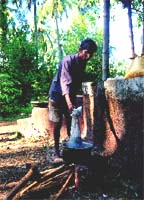 The banawali type is what is indigenous to the region and the tree lives up to its reputation of being �kalpa vriksha� or something that can be used entirely. Nearly all parts of the tree are used from the milk to the flesh, bark, leaves, husk and shell.
Nagwekar who has been overseeing activities for 12 years and his colleagues at the centre have a busy year ahead. As the research station celebrates its golden anniversary a host of activities has been planned. From a farmers rally, a seminar to be held in April or May and lectures and training workshops to follow in October and November.
The banawali type is what is indigenous to the region and the tree lives up to its reputation of being �kalpa vriksha� or something that can be used entirely. Nearly all parts of the tree are used from the milk to the flesh, bark, leaves, husk and shell.
Nagwekar who has been overseeing activities for 12 years and his colleagues at the centre have a busy year ahead. As the research station celebrates its golden anniversary a host of activities has been planned. From a farmers rally, a seminar to be held in April or May and lectures and training workshops to follow in October and November.